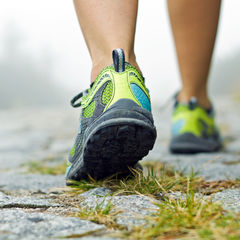-
5 Helpful Exercises for Diabetes Sufferers
Saturday, December 13th, 2025By Sue Cotey and Andrea Harris, Registered Nurses
How Regular Aerobic Activity Can Reduce Your Need for Insulin
If you suffer from diabetes, exercise can provide some surprising benefits. Not only does physical activity lower your stress levels, it also lowers your blood sugar level.
So, how much exercise is needed? For individuals with diabetes, The National Institutes of Health (NIH) recommends 150 minutes of aerobic exercise per week.
Exercise is vital for people with diabetes – that’s why the American Diabetes Association (ADA) recommends that diabetes patients go no more than two days without exercise.
Exercises for Diabetes: “The Fab 5”
There are a variety of exercises available to help people with diabetes. Here are our five favorites:
Swimming: Swimming relaxes and lengthens your muscles without putting pressure on your joints.
 For those individuals with diabetes or at risk for developing the disease, research shows that swimming helps to improve cholesterol levels, burn calories and lower stress levels.
For those individuals with diabetes or at risk for developing the disease, research shows that swimming helps to improve cholesterol levels, burn calories and lower stress levels. We recommend that you swim at least three times a week for ten minutes or more to get the most benefit.
As your endurance and strength improve, you can gradually increase the length of your workout.
Be sure to have a snack before swimming and monitor your blood sugar levels. Last but not least, let the lifeguard know you have diabetes before you enter the pool.
Yoga:
 A traditional type of exercise, yoga uses fluid movements that help build flexibility, strength and balance.
A traditional type of exercise, yoga uses fluid movements that help build flexibility, strength and balance. Yoga is beneficial for people with a variety of chronic conditions, including those with diabetes.
Doing yoga helps lower stress and improves nerve function, leading to an increased state of wellness and mental health.
According to the American Diabetes Association (ADA), yoga may improve blood glucose levels due to increased muscle mass.
Tai Chi:
 This form of exercise from China incorporates slow, smooth body movements to help relax the mind and body.
This form of exercise from China incorporates slow, smooth body movements to help relax the mind and body. A 2009 study at the University of Florida involved 62 Korean women assigned to one of two groups – a control group and an exercise group that began doing of Tai Chi regularly.
Those individuals who completed the tai chi sessions showed marked improvement in blood sugar control. Tai chi participants also reported increased vitality, energy and mental health.
Dancing:
 Dancing is not only terrific exercise for your body – remembering dance steps and sequences actually boosts brain power and improves memory.
Dancing is not only terrific exercise for your body – remembering dance steps and sequences actually boosts brain power and improves memory. For those people with diabetes, dancing is a fun and invigorating way to increase physical activity, reduce stress, promote weight loss, improve flexibility and lower blood sugar.
Chair dancing, which involves the use of a chair to support people with limited physical abilities, makes dancing for exercise possible for most individuals.
By dancing for just 30 minutes, a 150-pound adult can burn up to 150 calories.
Walking:
 Walking is the most popular exercise and one we highly recommend for people with diabetes.
Walking is the most popular exercise and one we highly recommend for people with diabetes. Pretty much anyone can do it anywhere!
Thirty minutes to one hour of brisk walking, three times each week is a simple and effective way to increase your physical activity.
Exercise Safety Tips for Diabetics
- Before starting an exercise program, consult your doctor to be sure the exercise you choose is appropriate and safe for your type of diabetes. Be sure to start slowly, especially if you have not been physically active for some time.
- Check your blood sugar levels before and after exercise until you understand how your body responds to exercise.
- Whether you have Type 1 or Type 2 diabetes, be sure your blood sugar is less than 250 mg/dl before starting to exercise. For those with Type 1 diabetes, exercising with a blood sugar higher than 250 mg/dl may cause ketoacidosis, which can be a life-threatening condition due to a lack of insulin in the blood.
- Do a five-minute warm-up and a five-minute cool-down before and after exercising.
- Always carry a cell phone with you.
- Avoid doing exercise in extremely hot or cold temperatures.
- Protect your feet by wearing proper shoes and socks.
- Drink plenty of water before, during and after exercise to avoid becoming dehydrated.
- Be prepared for spells of low blood sugar. Have something with you close at hand that can bring sugar levels up, such as hard candy, glucose tablets or a few ounces of juice.
- Wear a medical alert ID band. If and when an emergency occurs, EMS staff will know how to treat you properly.
- Pay attention to your body’s signals. If you become short of breath, dizzy or lightheaded, stop exercising immediately. Report any unusual problems you experience to your physician.
(published June 26, 2014)
 Sue Cotey, RN, CDE, and Andrea Harris, RN, CDE, are Diabetes Educators with the Lennon Diabetes Center at the Stephanie Tubbs Jones Health Center, Cleveland Clinic. Sue is the Program Coordinator. This outpatient diabetes program is designed to educate and teach effective self-management skills that put the patient in control. With a combined 25 years of experience, Sue and Andrea have helped thousands of diabetes patients live healthier lives through better nutrition and lifestyle choices. They are both frequent contributors to Cleveland Clinic’s Health Hub, a consumer health and wellness blog.
Sue Cotey, RN, CDE, and Andrea Harris, RN, CDE, are Diabetes Educators with the Lennon Diabetes Center at the Stephanie Tubbs Jones Health Center, Cleveland Clinic. Sue is the Program Coordinator. This outpatient diabetes program is designed to educate and teach effective self-management skills that put the patient in control. With a combined 25 years of experience, Sue and Andrea have helped thousands of diabetes patients live healthier lives through better nutrition and lifestyle choices. They are both frequent contributors to Cleveland Clinic’s Health Hub, a consumer health and wellness blog.


